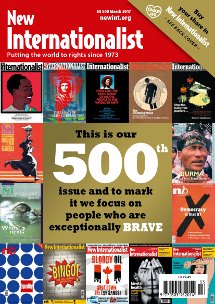Unfair on Nicaragua
In January, the magazine New Internationalist published one of its regular ‘country profiles’ on Nicaragua. In March, they published a brief letter from me complaining about the unfair picture they had presented. Below is the letter and below that the main text of the ‘country profile.’
Your country profile of Nicaragua gives a very unfair picture of the country I live in.
It lambasts the president, Daniel Ortega, as an ‘obstacle to progress’ when he has led massive reductions in poverty levels, has achieved near-universal schooling (when under his predecessor huge numbers of children didn’t go to school) and radically expanded the health service.
It is horrendous to liken him to the dictator Anastasio Somosa, who tortured and assassinated his opponents. Only later do you acknowledge some of the country’s achievements.
If it was as bad as you describe, would Nicaragua have surpassed Panama to become officially Central America’s safest country?
John Perry, Masaya, Nicaragua
New Internationalist Country Profile: Nicaragua

Six young revolutionaries pose on a photo from 1979. Side by side with Nicaragua’s current leader Daniel Ortega is Carlos Brenes. Then comrades, today they are fierce political opponents. ‘We thought that Ortega was a solution to our problems,’ says Brenes. ‘But he has turned out to be the biggest obstacle to Nicaragua’s progress.’
The retired colonel is one of a number of former guerrillas who believe that the President has betrayed the ideals of the Sandinista revolution and runs the country in a not dissimilar way to Anastasio Somoza, the dictator they toppled in 1979.
Ortega headed the revolutionary government in the 1980s and returned to power in 2007 after three rightwing governments. His Sandinista National Liberation Front (FSLN) party has gradually gained control over congress, the police, the military and the courts.
In 2009 the Supreme Court amended the constitution to allow Ortega to stand for re-election. He has since won two landslide victories, both amid reports of irregularities.
The President barred independent observers from monitoring the 2016 election and ran virtually without competition after a court ruling ousted the main opposition leader. The election was called ‘a farce’ by the opposition, saying it was marked by a high abstention rate – a claim that the government disputes.
The critics accuse Ortega of seeking to install ‘dynastic’ rule in Nicaragua. His family members reportedly control fuel companies, television stations and public works. Ortega’s wife, Rosario Murillo, was his running mate in the 2016 election and is now set to become vice-president.
Despite his authoritarian tendencies, Ortega enjoys genuine support among the poor as well as the business elite. Thanks to prudent macroeconomic policies, Nicaragua, the second-poorest country in Latin America after Haiti, has maintained growth levels above the region’s average. It has been spared the high rates of crime and gang violence that plague its northern neighbours. The poverty level has fallen from 42.5 per cent in 2009 to 29.6 per cent in 2014, according to the World Bank.
During the revolutionary period there was huge improvement in the spheres of health and education. Ortega has expanded access to public housing and services and introduced popular social programmes such as free roofing and farm animals for poor families.
But the progress has not reached everyone. In rural areas and in the autonomous regions of the Caribbean coast, access to basic services is a daily challenge – dirt roads are riddled with potholes, there is no running water and electricity is either nonexistent or suffers frequent power cuts.
State money is not always wisely spent. Murillo reportedly paid $3.3 million for 134 ‘trees of life’ – multicoloured metallic structures that line the main roads of the capital Managua and light up in the night.
Nicaragua’s national budget may soon come under strain – and particularly its social-welfare programmes, which have been backed by the country’s leftist allies. Venezuela is overwhelmed by an economic crisis and Cuba is normalizing relations with the United States.
Meanwhile, the US House of Representatives has unanimously passed legislation known as the Nica Act. This is meant to stop Ortega from accessing international loans until he adopts reforms that promote democracy, the rule of law and human rights, and conducts free and fair elections.
There is a long tradition of US intervention in Nicaragua. The five-year-long trade embargo imposed in the 1980s by Ronald Reagan strangled the Nicaraguan economy. At the same time, Washington sponsored counterrevolutionary groups known as Contras in a civil war that killed 30,000 people. There is a talk of a new war on the streets of Nicaragua. People say the country is at a crossroads and it can go either way.
The full country profile, with facts and figures, can be read in the New Internationalist
